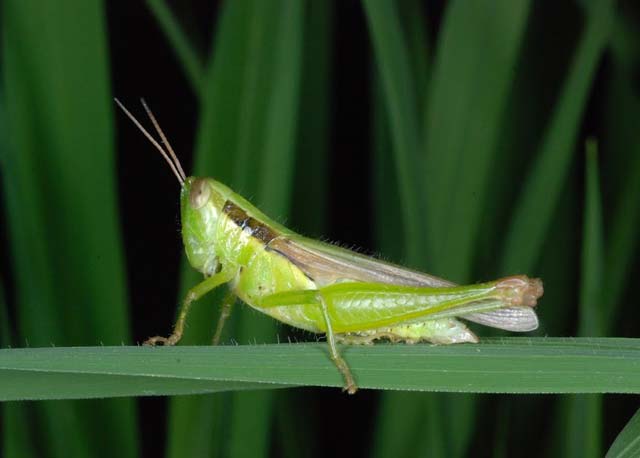Grasshopper (Short-horned) and Locust
Short-horned grasshopper and Oriental migratory locust both infest the rice plant, and have similar feeding damage.
What it does
Feeding damage caused by short-horned grasshoppers and oriental migratory locusts result to cut out areas on leaves and cut-off panicles. They both feed on leaf margins.
Why and where it occurs
Aquatic environments are suitable for the development of short-horned grasshoppers, while locusts may prefer dry environments. Both are favored by the presence of alternate hosts.
The short-horned grasshoppers are common in moist and swampy areas. These nocturnal insect pests are abundant during September and October.
Oriental migratory locusts are commonly found in all rice environments but they are more concentrated in rainfed areas. They dominate the irrigated rice environment surrounded by grassland breeding grounds. Both the adults and the nymphs are nocturnal and feed on the rice foliage at night. At daytime, they hide at the base of the plant. Under favorable conditions, the adults swarm and migrate.
How to identify
Check for feeding damage, such as
- feeding marks on leaves and shoots,
- large portions of leaf edges consumed, and
- cut-off panicles.
Check for insect presence:
- eggs in pods
- presence of yellow and brown nymphs and adults feeding on rice foliage
Grasshopper and locust damage can be confused with damage caused by other defoliators. To confirm, find the insect and the characteristic form of leaf damage.
Why is it important
Both species can be important pests of the rice crop. The nymphs and adults feed on the leaf by consuming large amounts of leaves. Serious damage caused by short-horned grasshoppers has been reported in Vietnam and China.
Oriental migratory locust migrates in swarms and can be highly abundant. Outbreaks of the insect pest usually occur during drought. Records showed outbreaks in China, Philippines, Sabah, and Malaysia.
How to manage
- Flood the stubbles, shave bunds, sweep along the bunds, and pick adults directly from the foliage at night when they are sluggish.
- Encourage biological control agents: scelionid wasps, parasitic flies, nematodes, and fungal pathogens, birds, frogs, and web-spinning spiders, and a certain species of an entomophthoralean fungus; and platystomatid fly and mite (eggs of oriental migratory locust), ants, birds, bats, field rats, mice, wild pigs, dogs, millipedes, fish, amphibia, reptiles, and monkeys.
- Use poison baits from salt water and rice bran.
- Use foliar sprays to control grasshoppers in rice fields. Granules are not effective.
